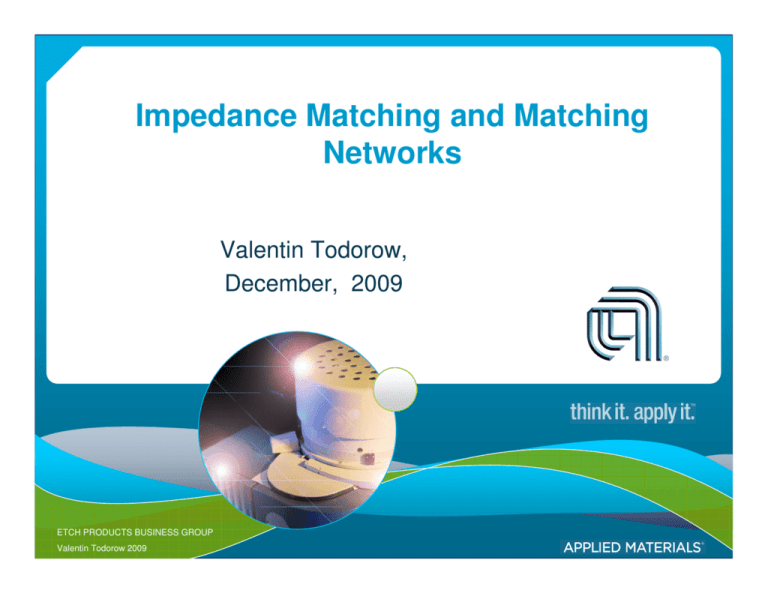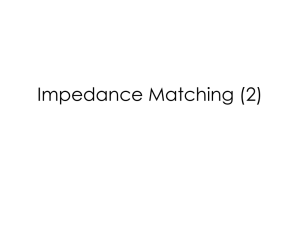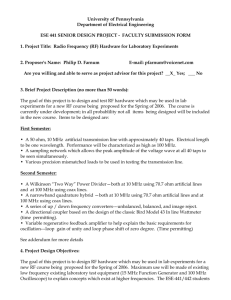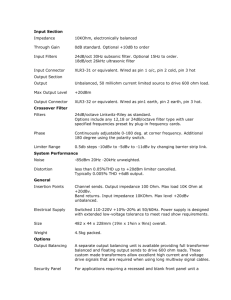Impedance Matching and Matching Networks
advertisement

Impedance Matching and Matching Networks Valentin Todorow, December, 2009 ETCH PRODUCTS BUSINESS GROUP Valentin Todorow 2009 RF for Plasma Processing - Definition of RF What is RF? The IEEE Standard Dictionary of Electrical and Electronics Terms defines RF as: Radio frequency is the frequency in the portion of the electromagnetic spectrum that is between the audio frequency and infrared portion. Typically between 20 kHz and 300 GHz. Band designation: – – – – HF VHF UHF Microwave 3 – 30 MHz 30 – 300 MHz 300 – 1000 MHz above 1 GHz 2 ETCH PRODUCTS BUSINESS GROUP Valentin Todorow 2009 RF for Plasma Processing Why RF for Plasma Processing? 1. To sustain plasma a closed loop circuit is needed. Current need to flow from generator through the wafer, plasma, chamber wall back to the generator. DC would be perfect for PVD sputtering because the target is conductive and DC current can flow through it. In the case of a semiconductor wafer which is under normal conditions dielectric DC current can not flow through it and plasma can not be sustained. From basic electrical science we know that AC current can flow through dielectrics. So an AC energy is needed drive current through a dielectric wafer for plasma processing. 2. Plasma properties: Different frequencies create different plasmas densities and sheath voltages. 3 ETCH PRODUCTS BUSINESS GROUP Valentin Todorow 2009 Impedance Matching – Why? Impedance matching is needed to provide maximum power transfer between the source or RF energy and its load. This is especially important if you deal with low amplitude signals. Imagine a radio or TV antenna. To get a good reception every bit of this signal needs to be used and the designer can not afford any signal loss – a perfect match is desired. So the first reason for matching is just power efficiency. The second reason is device protection – If RF circuit is not matched we get reflected power. This reflected power builds standing waves on the transmission line between the source and load. Depending on the phase between the forward and reflected both waves can either subtract or add. Because of that on the line we can get places where the voltage is the sum of both voltages or eventually places where the voltage equals zero (maximum current). If the standing wave is positioned in such a way on the transmission line so that the maximum voltage or current is applied to the power FET’s they can be destroyed. 4 ETCH PRODUCTS BUSINESS GROUP Valentin Todorow 2009 Impedance matching – Definition What do we mean by impedance matching? – For DC it is well known theorem that maximum power transfer can be achieved if source resistance is equal to the load resistance. – For RF we consider impedances. The condition for impedance matching is that real part of the impedance should be equal to the real part of the load and reactance's should be equal and opposite in character. For example if our source impedance is R + jX to achieve matching our load should be R – jX. If we assume that we have a chamber with capacitive discharge the impedance in general will be R – jX. Generator typical output impedance is 50 Ohms. Then the matching network has to make 50 = Rl and jX = 0. 5 ETCH PRODUCTS BUSINESS GROUP Valentin Todorow 2009 Impedance Matching Let us match a 50 ohm generator to a 2 Ohm load. One of the ways to match is to put a resistor in parallel to the output of the generator. 50 Ohm 2.09 Ohms 2 OHm 13.56 MHz Z= R1xR2 R1+R2 = 2 Ohm Matching will be achieved, however not a desirable solution because most of the power will be lost in the resistor we added. I have chosen here to make 50 Ohm side look as 2 Ohm because it is easier to correlate to the L circuit which we will derive later. 6 ETCH PRODUCTS BUSINESS GROUP Valentin Todorow 2009 Impedance Matching Now lets see what will happen if we replace the resistor with a capacitor of 1150 pF which has impedance X=1/2ΠfC =-j10.207 Ohm @ 13.56 MHz 50 Ohm 10.207 Ohms 2 OHm 13.56 MHz R.(-jX) Z= R+(-jX) = 2 – j 9.8 Ohms One can see that by adding the capacitor we were able to transform 50 ohm in to a complex impedance with a real part of 2 Ohms. 7 ETCH PRODUCTS BUSINESS GROUP Valentin Todorow 2009 Impedance Matching One can see that by adding the capacitor we were able to transform 50 ohm in to a complex impedance with a real part of 2 Ohms. So half of the job is done. -j9.8 50 Ohm 10.207 Ohms 13.56 MHz R.(-jX) Z= R+(-jX) 2 Ohm 13.56 MHz = 2 – j 9.8 Ohms If we find a way to make the imaginary part equal to zero then the match will be complete. 8 ETCH PRODUCTS BUSINESS GROUP Valentin Todorow 2009 Impedance Matching From electrical science we know that inductors and capacitors have impedances with opposite signs. Inductors have positive sign and capacitors negative. 9.8 Ohm 50 Ohm 13.56 MHz 10.207 Ohm 2 Ohm 13.56 MHz So if we add an inductor which impedance value @ 13.56 MHz is 9.8 Ohm Inductor and capacitance will cancel each other and our match will be complete. L=115 nH @13.56 MHz 9 ETCH PRODUCTS BUSINESS GROUP Valentin Todorow 2009 Basic L Matching Network This way we arrived to the basic and most used L shape matching network. By using capacitors and inductances we can achieve impedance matching without power loss assuming the components are ideal. Real capacitors and inductors exhibit losses which need to be minimized during the match design. The most critical component is the inductor. At high frequencies the skin effect and inter winding capacitance decrease the quality of the coil. X1 X1 := Rs X2 2 ( Rs⋅Rp) − Rp Rp X2 := Rs⋅ Rp X1 Rs>Rp 10 ETCH PRODUCTS BUSINESS GROUP Valentin Todorow 2009 Basic L Matching Network Two types L matching networks – Until now we matched real load to real load. What to do when we have reactance? High - Low Low - High Parallel, also known as shunt or load capacitor is always on the high R side. Called “load” capacitor because it adjusts the real part of the load. Series sometimes called “tune” because it tunes out the reactive part of the load. 11 ETCH PRODUCTS BUSINESS GROUP Valentin Todorow 2009 RF for Plasma Processing – Matching Networks There are three basic matching networks used in RF designs - they are L, Π and T configuration. Each of them has advantages and disadvantages. Most commonly used matching network in plasma processing is the L circuit. The reasons are: Simplicity - Easy to build auto matching networks. It has only two components to be controlled for adjusting the real and imaginary part of the impedance. Practical component values - some of configurations require either very low inductance values or very high capacitance values which is impossible to make especially when you have to design auto matching network with a wide tuning range. The quality factor Q of the circuit is determined only from the source (generator) and load (plasma impedance) and does not depend on the external components - this is may be the most important property of the circuit. What this means is that for certain load impedance there is only one combination of L and C to match that load. Q := Rsource − 1 Rload 12 ETCH PRODUCTS BUSINESS GROUP Valentin Todorow 2009 Basic L Matching Networks T and Pi network require more complex control algorithm for automatic matching network design. Need to control three components which makes it more expensive. The disadvantage of the L circuit - it can match loads equal or less than 50 Ohm. If the L circuit is reversed it can match loads equal or higher than 50 Ohm. It can not match on both sides. For example If the load is changing from 35 to 100 Ohms a reversed L network will match only from 50 up to 100 Ohms and will not match from 35 to 50 Ohm. 13 ETCH PRODUCTS BUSINESS GROUP Valentin Todorow 2009 Pi Network X2 Rs Q := X3 X1 Rl Rs Rl X1 := −Rl⋅ Q2 + 1 − Rs Rl Rs>Rl X21 Rs − 1 Rx X22 ( Q ⋅Rs) − Rl⋅ Rs X1 X2 := 2 Q +1 X3 Rx X1 X3 := −Rs Rx < Rl < Rs Q Can be represented as two L circuits connected together matching in to an Imaginary load Rx which has to be smaller than Rs and Rl and is used to calculate 14 Q of the circuit. ETCH PRODUCTS BUSINESS GROUP Valentin Todorow 2009 T Network X3 X1 Q := Rx − 1 Rl Rs X2 Rl X3 := Rl⋅Q X2 := −Rl⋅ Rx > Rs > Rl ( 1 + Q2) ( 1 + Q2) Rl⋅ − 1 Q + Rs ( 1 + Q2) −1 X1 := Rs⋅ Rl⋅ Rs Could be represented as two L circuits connected together through their shunt Component. The imaginary resistor Rx this time has to be larger than both Rs and Rl. Q is defined as the ratio between Rx and the smallest load resistance. 15 ETCH PRODUCTS BUSINESS GROUP Valentin Todorow 2009 Smith Chart 16 ETCH PRODUCTS BUSINESS GROUP Valentin Todorow 2009 Using Smith Chart to Design Matching Networks Lets match a Z=2-j35 to 50 ohm which is representative of capacitive plasmas. We will be using an L circuit and will be moving from the load to the generator. The first step will be to add the series inductor. The value of the inductor should be increased untillGROUP the trace crosses the 50 Ohm circle. ETCH PRODUCTS BUSINESS Valentin Todorow 2009 17 Using Smith Chart to Design Matching Networks The next step will be to add the shunt capacitor. The value is increased until the trace crosses the 50 Ohm point. The design is ready. Component values can be red from the chart. 18 ETCH PRODUCTS BUSINESS GROUP Valentin Todorow 2009 Using Smith Chart to Design Matching Networks Lets match a Z=2+j35, which is representative of inductive plasmas. Will be also using L circuit and will be moving from the load thoward the generator. Normally a L circuit consists of series inductor. Here the inductor is part of the load and it is larger than what we need. Because of that our series component will be a capacitor to compensate for the excessive inductance. Cap Value will decrease untill we cross 50 Ohm circle. 19 ETCH PRODUCTS BUSINESS GROUP Valentin Todorow 2009 Using Smith Chart to Design Matching Networks Second step will be to add the shunt component and the impedance transformation is completed. 20 ETCH PRODUCTS BUSINESS GROUP Valentin Todorow 2009 Matching Networks Design Considerations Match range – determined by plasma impedance range. Usually determined empirically. One can use existing matches or design its own box with variable components. Use this matches to manually tune in to plasma condition. Plasma impedance can be determined two ways: – Load the input of your box with a 50 ohm load and measure the impedance on the match output. – Measure the values of the series and shunt component and calculate the impedance. Why chamber impedance is important? – Determine range of values for the series and shunt component. – Determine current and voltage capabilities of the components 21 ETCH PRODUCTS BUSINESS GROUP Valentin Todorow 2009 Matching Networks Design Considerations Determining RF current through the match – We will use the already known equation for the quality factor: Q := Rsource − 1 Rload Use the lowest value for Rload you have measured and calculate Q. From resonant circuit theory we also know that the current within the circuit = outside current x Q. outside current can be calculated from Ohms law using the maximum power which the match will handle and 50 Ohms as source impedance. For example for 3 kW Current will be: R := 50 P := 3000 I := P R I = 7.746 For Rload= 1 ohm Q will be 7. Then match current will be 54A. 22 ETCH PRODUCTS BUSINESS GROUP Valentin Todorow 2009 Matching Networks Design Considerations Series leg design – If you have a look at the L matching network topography you will see that series leg is an inductor. In auto matches we use variable components and it is hard to design variable inductors. Because of that a series combination of L and a variable C is used. From the equation below one can see that if we vary Xc and Xc<Xl the impedance of the series leg remains inductive. This way we can have a variable inductor. X := Xl − Xc Inductor design consideration – coil is the major loss component in the match. Because of the high current and skin effect real losses in the coil can be significant if it is not sized properly. Coil temperatures can reach more that 150 degree C if the cross section is not selected taking in to consideration the skin dept at the frequency of operation, 23 ETCH PRODUCTS BUSINESS GROUP Valentin Todorow 2009 Matching Networks Design Considerations Shunt leg design – In many cases a large value for the shunt capacitor is required. In this case the designer has two options – Use fixed capacitance in parallel with the variable cap. The back draw of such design is that it shifts the impedance. It expands the range at higher end, however it limits you at the lower end. – A better solution is a series combination of variable capacitor C and a small inductor. When Xc is at its max value and Xl<<Xc the total X is almost unchanged. So there is no limiting at the upper end of the tuning range. If Xc is at its lower end and Xc is comparable but higher to Xl the value of X will be drastically changed. For example if Xc is 2 Ohms and Xl=1 Ohm, the total impedance will be 1 ohm which is like doubling the capacitance in value. With such design one needs to make sure that you are not operating at series resonance (Xl=Xc) at the operating frequency because currents in the leg will be enormous. X := Xl − Xc 24 ETCH PRODUCTS BUSINESS GROUP Valentin Todorow 2009 Matching Networks Design Considerations Parasitic reactance – every piece of wire will exhibit inductance and capacitance to ground. Previous circuits we analyzed do not include any of this stray inductance or capacitance. In real world design all this should be considered, especially at high frequencies. The rule is keep wires as short as possible and as far as possible from ground. If not possible every parasitic should be analyzed and included in your schematic. 25 ETCH PRODUCTS BUSINESS GROUP Valentin Todorow 2009 Matching Networks Design Considerations- Grounding Straight wire inductor – – – – – – – – – L = 0.002l[2.3 log(4l/d – 0.75)] uH l = wire length in cm d= wire diameter in cm Lets assume a 2mm diameter wire with 30 cm and 100 cm length L30 = 0.38 uH L100 = 1.5 uH @50 Hz impedance will be: X30 = 0.00012 Ohm X100 = 0.00047 @13.56 MHz the impedance will be: X30 = 32 Ohm X100 = 128 Ohms From the above example we can see that what is considered ground for AC is not a ground for RF. Higher the frequency higher the impedance of a wire. 26 ETCH PRODUCTS BUSINESS GROUP Valentin Todorow 2009 27 ETCH PRODUCTS BUSINESS GROUP Valentin Todorow 2009







